“Bavarian cuisine is characterized by hearty and savory dishes that should be enjoyed without counting calories,” says Manuel Madei. The chef of the Feuerküche at Gut Sonnenhausen introduces us to the “must eats” of Bavaria and how a sustainable diet can go with them.
This is the fourth in our Culinary Journey series – a new destination each month.
Down-to-earth cuisine with rural origins

Bavaria is located in the south of Germany, bordering the Alps and Austria. This cuisine originated in rural areas and features hearty meat dishes, dumplings, and pastries. Traditional dishes are still popular today,
In Munich there are some modern representatives of tavern culture. People consider the absence of meat and dairy products “modern”. For example, the vegan restaurant “Bodhi” in Munich serves “soy steak” instead of pork knuckle or “Keesspatzn” (cheese spaetzle without cheese).
“Vegan spreads more popular than cheese alternatives”
At least that’s the way chef Manuel Madei of the Green PearlsⓇ Hotel Gut Sonnenhausen sees it. While homemade vegan spreads are popular with guests for breakfast, “vegan sausage and cheese” are neither offered nor in demand.
The Gut Sonnenhausen is located about 35 kilometers south of Munich and was originally a stud farm. It is certified organic and has its own organic farm. Everything not produced on the farm comes from its sister farm, Herrmannsdorfer Landwerkstätten (where organic cattle, pigs, chickens and lambs are raised).
Manuel works with a farm-to-fork concept: “The combination of our own vegetable garden, organic farming and the Herrmannsdorfer Landwerkstätten allows me to process high quality and interesting food freshly and put the best on our guests’ plates,” he says. The inspiration for his dishes comes from walks in the woods with his dog, Tyras. He also values the “nose to tail” approach, ensuring that every part of the animal is used.
From Nose to Tail
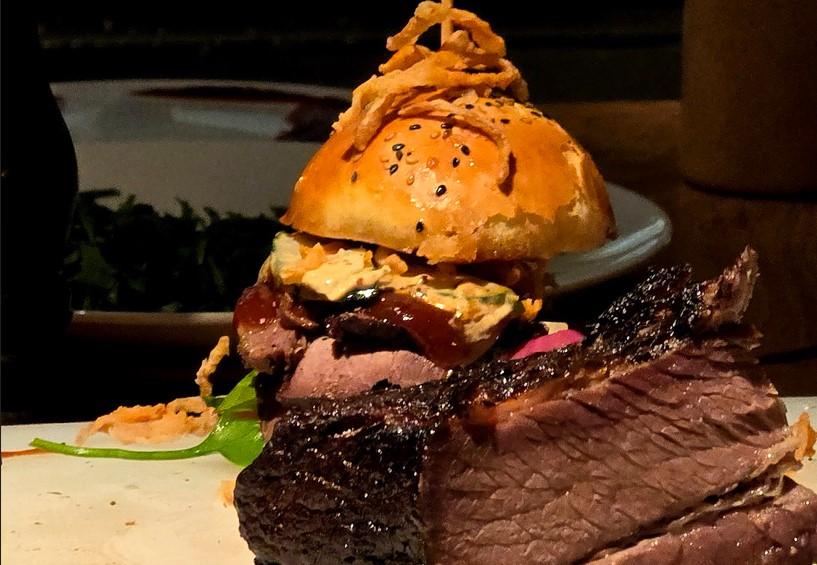
The young chef sees meat as a fundamental part of Bavarian cuisine. In his opinion, regional organic meat should be used to make consumption ecologically justifiable. This guarantees species-appropriate husbandry, promotes organic farming in the region and avoids transportation emissions.
He also considers it important to use the whole animal. That’s why he praises and recommends Bavarian offal cuisine, which uses liver, kidneys, and other parts.
The FARMER’s CLUB restaurant is also open to external guests for breakfast, business lunch and dinner. The highlight is the 3-course menu on Sundays with organic roast pork from the Herrmannsdorfer Landwerkstätten, which is made from the local “Schwäbisch Hällische” pig.
Gardening according to the principles of permaculture
The kitchen garden at Gut Sonnenhausen provides Manuel’s kitchen with fresh vegetables, fruits and herbs at harvest time. Designed according to permaculture principles, it requires only a manageable amount of water, even in the summer, because the plants protect and support each other. If you are interested in this type of organic vegetable gardening for your own backyard, read gardener Marie Louise Troll’s tips here. She is in charge of the gardens around Gut Sonnenhausen.
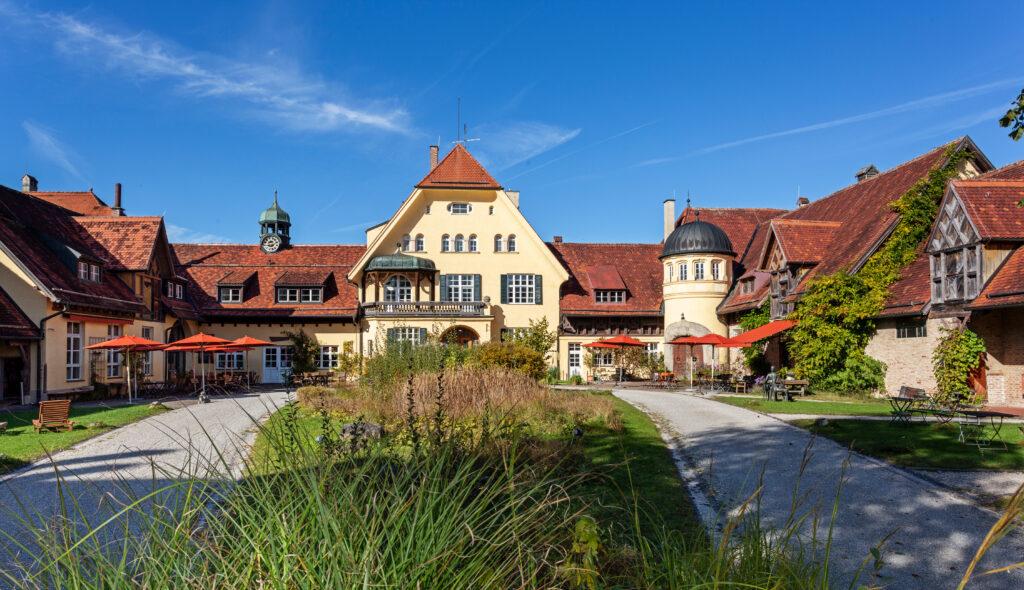
These are the hearty must-eats in Bavaria
We asked Manuel which dishes are a must on a gourmet trip through Bavaria. Here are his recommendations:
#1 Resche roast pork belly with dark beer sauce, bread dumplings and caraway and pointed cabbage salad
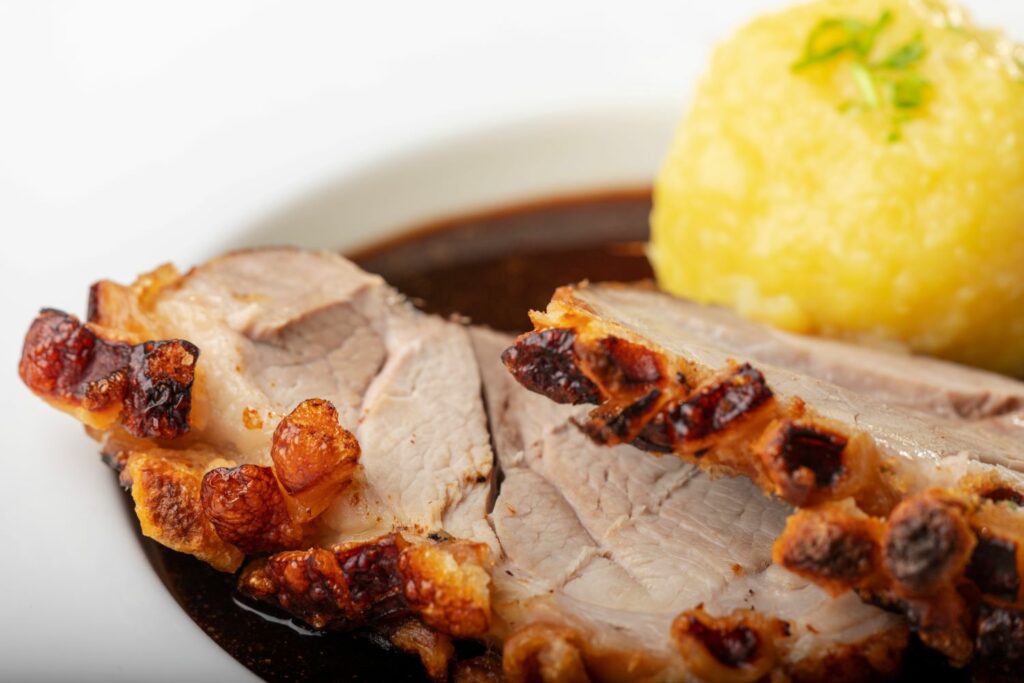
Something that is “Resch gebraten” means that it has a hard crust. Unlike potato dumplings, cooks make bread dumplings from old bread rolls (“Semmeln”).
#2 Boiled “Tafelspitz” with grated horseradish and bouillon vegetables

The “Tafelspitz” gets its name from its triangular shape. It is the rear part of the beef rump. The meat is very lean and somewhat coarse. In Bavaria (and also in Austria) it is customary to sell this cut separately, resulting in several Tafelspitz dishes.
#3 Sour “Lüngerl“
As mentioned above, offal is one of Bavaria’s specialties. A “Saures Lüngerl” is a ragout of veal lung with bread dumplings. They serve it in a soup bowl.
#4 Liver Dumpling Soup

Another dish that proves you can enjoy the whole animal is liver dumpling soup. This is a clear broth with liver dumplings. Cooks make these from beef liver (sometimes pork liver) mixed with bread, eggs, parsley, and other spices.
Bavarian Dessert and Pastry Recommendations
In Bavaria, bakers prepare apple pies in countless variations, as farmers have grown this fruit in the region for centuries. People consider the apple the oldest cultivated fruit tree. However, many dishes sold as “classics” in Bavaria originally come from neighboring countries.
#5 Apple strudel with vanilla ice cream (or vanilla sauce)
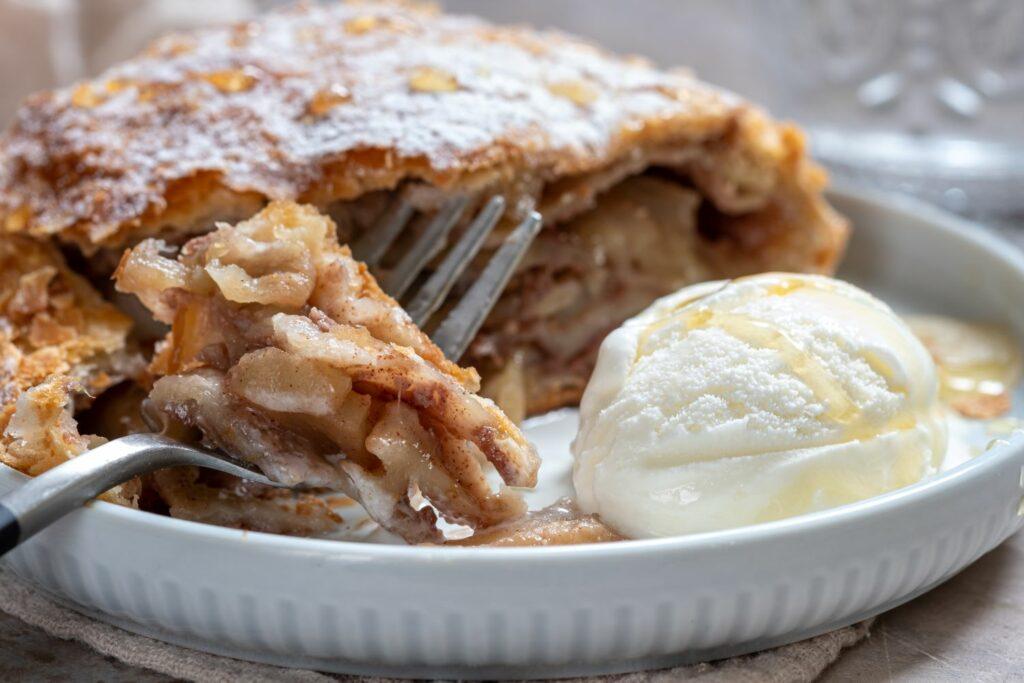
Apple strudel is popular not only in Bavaria, but in all the countries that once belonged to Austria-Hungary (1867-1918). Boiled apple pieces with cinnamon sugar and raisins are rolled into a flaky strudel dough. Delicious hot or cold! Vanilla sauce was added later. (You can read more about Madagascar vanilla and sustainability in our Patisserie blog post).
#6 Tarte Tatin
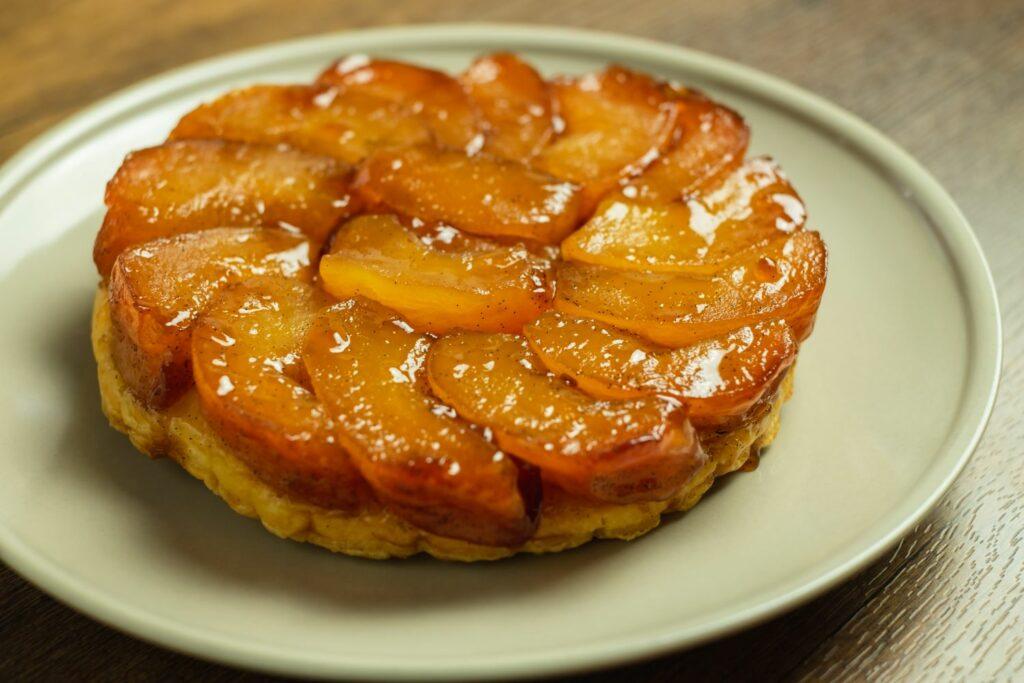
Tarte Tatin is actually of French origin, but according to Manuel it is a common pastry in Bavaria, which he recommends for its “fine taste”. Interestingly, it was the signature tart of a 19th century French hotel (Hôtel Tatin). Bakers prepare it as a caramelized apple tart baked upside down.
#7 Crostata

Crostata also originated on the other side of the Alps, in Italy, but its simplicity makes it a perfect addition to Bavarian cuisine. It consists of a shortcrust pastry base spread with jam and topped with a shortcrust lattice. “Simply delicious,” says Manuel.
#8 Linz Torte
“The Linzer Torte is always perfect for special occasions or just to enjoy at home with family and friends,” says Manuel. It was invented in Austria, where confectioner Johann Konrad Vogel (1796-1883) made it famous. He had emigrated from Bavaria to Linz, where he was the first to mass produce the cake.
The Linzer Torte (similar to the Corstata) consists of shortcrust pastry with jam and a lattice topping. What makes it special is the shortcrust pastry. Linzer Torte has a high nut content, usually almonds or a mixture of almonds and hazelnuts.
Drink tip from Manuel: “In Sonnenhausen I discovered the Kräuter-Garten-Spritz (herbs + white wine and sparkling water). It’s made with herbs from our own garden, tastes fresh, a little sweet and naturally sparkling”.
Conclusion
Regional agricultural products play an important role in Bavarian cuisine. Meat, eggs, milk, flour, apples, potatoes, and onions are among the classic basic ingredients used in many traditional dishes. In modern cuisine, however, vegetables are coming out of their shadowy existence as side dishes. Horseradish, white cabbage, celery, and carrots, which grow in this part of Germany, are particularly popular.
Save this article to Pinterest!

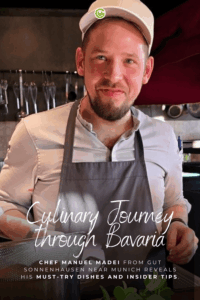
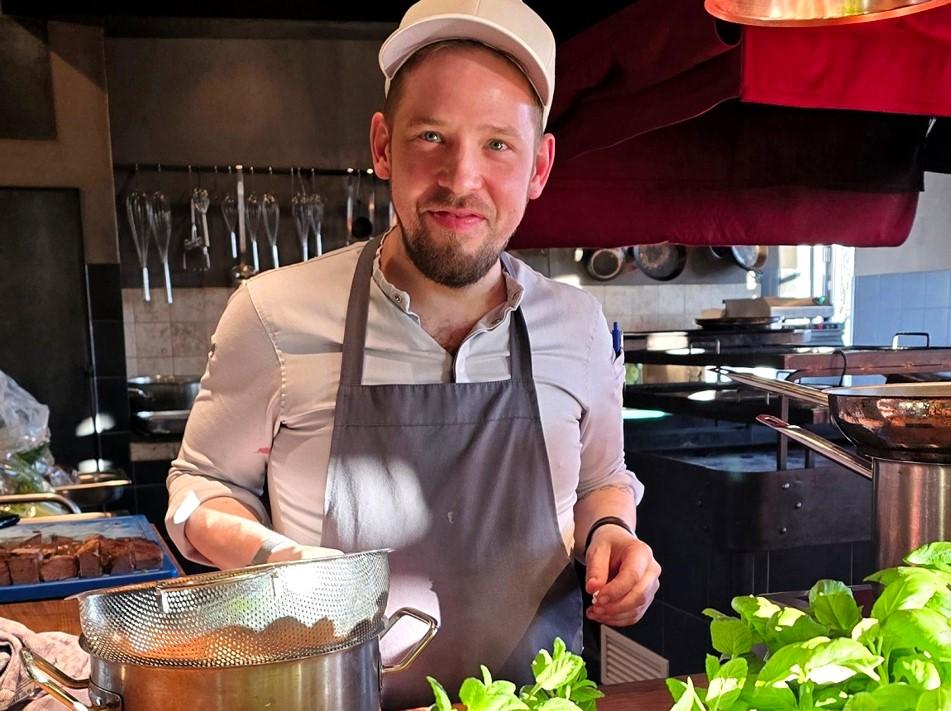


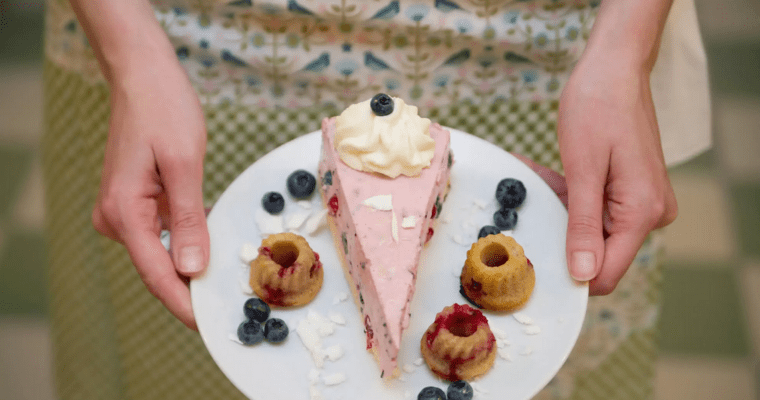

It’s fascinating to see how traditional Bavarian cuisine is adapting to modern sustainability trends without losing its identity. Chef Madei’s focus on vegan spreads rather than processed substitutes feels like a more authentic and thoughtful evolution.